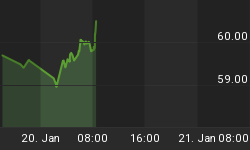Below are extracts from a commentary posted at Is gold under-valued? For anyone with a time horizon of one year or longer it makes no sense to analyse the gold market in isolation. This is because it is not possible to come to a sensible conclusion about the long-term outlook for gold unless you also have a well-grounded opinion on what is likely to happen to asset prices, interest rates, currency exchange rates, inflation, and real economic growth. The price of gold is just a reflection of the financial world, so even if we didn't speculate in anything other than gold bullion we would need to spend as much time analysing the other financial markets as we do now. Further to the above, it is really not appropriate to say that gold is currently under-valued unless you specify what it is under-valued relative to. And in this respect it is not enough to say that gold is under-valued relative to the US dollar because the dollar's value, like gold's value, is determined by each individual based on his/her perception of the world. Value is always at least partially subjective (of value to whom and for what?) and this is even more so with the dollar and gold than it is with, say, stocks or bonds or real estate, because neither the dollar nor gold has a yield that we can compare with historical records in order to quantify its current level of under- or over-valuation. It is also not appropriate to say that gold is under-valued now simply because it is trading well below it's 1980 peak. It could be argued, for instance, that the 1980 peak was an aberration and that it has taken the past 24 years for gold to work its way back to a level where it is fairly valued. In the cases of both gold and the dollar, the terms under- and over-valuation only have meaning for each market participant when referenced to that individual's perception of the world. As far as we are concerned, gold is dramatically under-valued because our research indicates that the markets are grossly under-estimating the US inflation problem. We are not so arrogant, though, that we rule out the possibility of a reasonable person coming to the opposite conclusion; although having said that we can't think of anyone who we would put in the "reasonable" category who thinks gold is over-valued at its current level.
Currency Update
In last week's Interim Update we noted that the euro's break below support was a sign that the dollar had already bottomed, but that the Dollar Index had not yet displayed enough strength to convince us of this. In particular, we mentioned that it remained below its 50-day MA and that Wednesday's rebound had halted at the short-term trend-line. Friday's upward move in the US$ has, however, shifted the odds firmly in favour of a bottom being in place. For example, the Dollar Index's short-term downtrend has been decisively breached and the euro has dropped below the bottom of its upward-sloping channel (see charts below). The Dollar Index also managed a marginal close above its 50- and 200-day moving averages at the end of last week.


Our intermediate-term target for the Dollar Index over the past 2 months has been 100 and last week's action suggests that a rally to around this level has begun. This doesn't mean, though, that it's onward and upward for the US dollar from here because even if our view is on the mark there will, of course, by pullbacks along the way. In fact, we would not be surprised if last week's obvious confirmation of strength in the buck was followed, in fairly short order, by a 1-2 week pullback. What it does mean is that the dollar should now start making higher lows and higher highs.
On a side note, when a market makes a sizeable move in one direction it prompts commentators to come up with 'reasons' for the price move. These reasons will often be wrong, but as long as the price continues to move in that direction the reasons will look right. So if the Dollar Index works its way up to our target of 100 over the coming 6 months be aware that a bunch of fundamental 'reasons' will be concocted to explain the rally and most of these explanations won't be realistic. For example, it's a fair bet that strong US productivity growth and real economic growth will be trumpeted in some quarters as reasons for a dollar rally, but such explanations should be ignored unless there is a dramatic change in the structure of the US economy over the next few months. Another explanation that might emerge revolves around the idea that US consumer debt represents a massive short position on the dollar and that the dollar is experiencing a short-covering rally due to US households paying back their debts. This explanation won't make any sense, though, unless the total supply of credit happens to be contracting at the time (you can't have a short-covering rally when the short position is expanding).
As mentioned in previous commentaries, if a dollar rally does unfold as per our expectations then it will most likely be driven by technical factors, sentiment, central bank intervention, and the unwinding of carry trades and other short-term trades that were based on the perception that US interest rates were going to remain low indefinitely.















